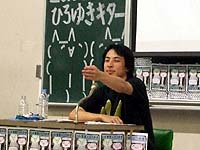I’m just trying to get my head around this story from FujiSankei Business-i:
MOF vs. MIC, local entities in deepening conflict over budget
FujiSankei Business i. 2006/11/6
Hot issues: JFM, early return of FILP funds
Leading up to the 2007 budget revision, conflict is deepening between the Ministry of Finance, which touts fiscal reconstruction, and the Ministry of Internal Affairs and Communications (MIC), which is backed up by the sentiments of local self-governing groups (i.e. municipalities). The two major issues are the scheme of how to deal with the Japan Finance Corporation for Municipal Enterprises (JFM), a government-owned financial institution slated for abolishment, and compensation for the early payback of funds from the Fiscal Investment and Loan Program (FILP). Debate is likely to heat up going into Nov 21, when the Deliberative Council on the Fiscal System (an advisory body to MOF) is set to finalize its budget proposal.
The MIC/municipalities side has taken the stance that the national government should subsidize the regional areas through various program revisions. MOF, meanwhile, has emphasized that the nation’s fiscal condition is even worse than that of regional areas. The two sides have collided head to head, with MOF offering up such criticisms as “The regional areas are not making serious efforts to reform the civil service.”
A typical example of this conflict is found in the JFM issue. The JFM historically procured funds from the market by issuing government-backed bonds, and lent those funds at long-term, low interest to municipalities’ water/sewage systems, hospitals, etc. However, after it is eliminated in 2008, it will transition into a new organization owned by the municipalities. The issue here is how to deal with the 2.6 trillion yen in reserves that the corporation had built up in preparation for a rise in interest rates.
MOF is of the position that, since the JFM is a 100% govt-owned financial insitution, “the leftover assets should be widely used for the people for fiscal reconstruction etc,” and is demanding that the reserves be placed in the national treasury. The MIC, in response, claims that the entire sum should be handed down to a successor organization to be jointly owned by the municipalities. At present there is no compromise in sight.
Meanwhile, the issue of compensation for early return of FILP funds began with a proposal from the municipalities. most loans received by municipalities from the government-owned financial institutions are long-term, with payback periods ranging from 20-30 years, and many of those loans were taken out during the era of high interest rates. As a result, the municipalities want to refinance while low interest rates continue, but in that case they will be required to pay compensation. Since the compensation depends on the number of years left on the loans, in reality, it will cost the majority of the future interest burden.
To that, the MIC is demanding the introduction of a system to eliminate the compensation requirement, but MOF has expressed virulent opposition. Since the compensation system was made clear in the contract signed at the time of the loan, the MOF’s stance is that the arrangement is valid whether the interest rates go up or down. Masaaki Honma, chairman of the MOF’s FILP Committee and member of the Deliberative Council, harshly questions the MIC’s attitude, remarking, “Eliminating the payment of compensation that was stipulated in the contract would be defaulting.”
The rift between the two sides is deep, placing focus on how the Prime Minister’s office will judge the matter. It will likely also be used as fodder to divine the depth of the PM’s leadership on near-term fiscal management.

 On Nov 20, I’m going to see a lecture by Alex Kerr (pictured, bottom), a businessman in Japan and Thailand and author of
On Nov 20, I’m going to see a lecture by Alex Kerr (pictured, bottom), a businessman in Japan and Thailand and author of  “I went back to my parents’ house after my home address was revealed on the Internet, but harassing phone calls kept coming into my office. Even my customers started to distrust me, thinking that I had someone (harassing me).”
“I went back to my parents’ house after my home address was revealed on the Internet, but harassing phone calls kept coming into my office. Even my customers started to distrust me, thinking that I had someone (harassing me).”
